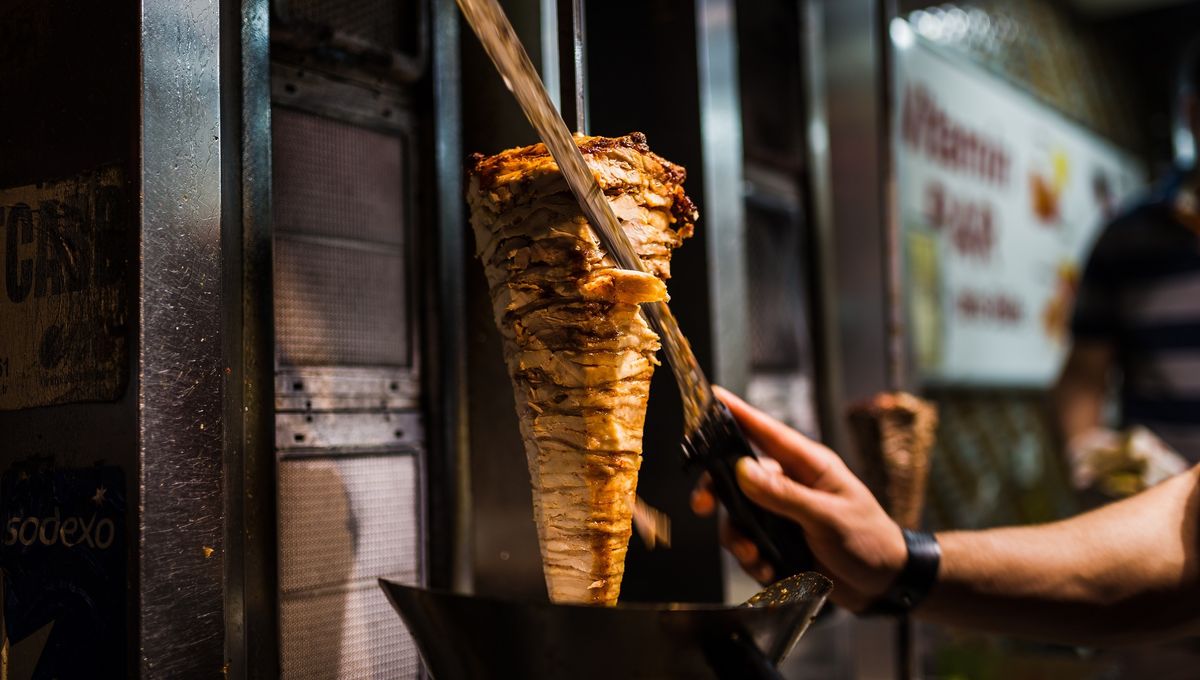
Doner Kebabs should be made of lamb, that’s pretty much the standard definition for what goes into the popular post-piss-up nosh (though opinion here is varied). But a recent YouTube video has divided viewers as it not only reveals how the meat is made but also what it is often made of. And let’s be clear, you may be lucky if it is lamb.
Doner kebabs, a staple of high-street fast-food vendors across the UK and Europe, come from the Turkish döner kebap – döner meaning “rotating” and kebap “roast meat”. The seasoned meat is generally cooked on a vertical rotisserie that forms a cone shape. As it turns, the meat is sliced down into thin shavings that are then stuffed into a pitta bread, along with salad and sauce. This type of kebab was made popular in the 1970s when it was first introduced in West Berlin by Turkish immigrants.
The “meat” part of the definition is the tricky point, especially in the UK. Although it could be interpreted broadly, most places consider a doner kebab to specifically contain lamb. The Oxford English Dictionary defines the (Styrofoam) dish as “consist[ing] of slices of lamb or mutton, layered with herbs and spices on a vertical spit”, while the British Food Standards Agency has previously emphasized that lamb is the requisite meat for a doner – if it isn’t lamb or mutton then it’s a different type of kebab and should be advertised as such.
So are you guaranteed to get lamb in your doner after a night out? Well, that is highly debatable. In the footage that has divided viewers – taken from Channel 4’s Food Unwrapped series – Jimmy Doherty samples a number of “doner kebabs” from different places and subjects them to chemical and DNA analysis. The results of which reveal that, out of the nine kebabs tested, only one contained just lamb. The rest consisted of chicken, beef, and pork. “Fortunately,” the forensic specialist the show consulted said, “we found no goat, no donkey, and no horse in any of the products.”
The presence of pork is particularly concerning for any Muslim or Jewish customers who may inadvertently buy a doner kebab expecting it to be acceptable.
But do these findings really matter given that most people tend to eat these things when they are more alcohol than person? Well, if you’re not too worried about what the meat is made of, you may not be a fan of how it is made.
The same footage also shows how to create Doner meat. It may come from lamb (supposedly) but few lambs appear in a cone shape stack.
How to make doner meat
In factories where kebab meat is prepared, the process starts with chunks of meat (often trimmings from supermarkets) being thrown into a large grinder where it is churned into mince. The resulting fleshy pulp is then moved into a separate vat where it is mixed with other ingredients – salt (to help its final structure), onion powder, and soya protein (to pad it out).
The final outcome is a meat containing around 85 percent lamb (or whatever), 5 percent seasoning, 5 percent bulking agent, and 5 percent rusk. The latter ingredient is a common feature of other meat products such as sausages, burgers, and pies, as it helps to hold the flavors, color, and seasoning.
The meat is then pounded into patty-shaped disks that are stacked on top of one another around a central spit. Lamb skin is placed between the layers to help bind the product together. Once stacked up, the overall meat-mass is trimmed into the characteristic cone shape and is ready to be cooked.
Sounds delicious, right? So the next time you’re swaying on your way home, you can make a more informed decision about what meal you want to munch. Though that does not mean you’ll necessarily get the meat you expect.
Source Link: People Are Just Learning What Doner Kebab Meat Is – They're Not Impressed